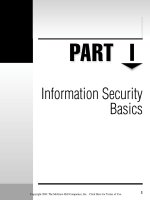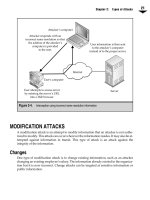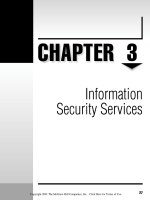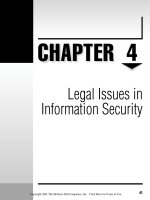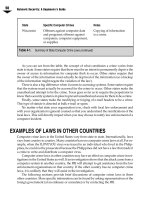Bảo mật hệ thống mạng part 18 pptx
Bạn đang xem bản rút gọn của tài liệu. Xem và tải ngay bản đầy đủ của tài liệu tại đây (96.26 KB, 7 trang )
104
Network Security: A Beginner’s Guide
Assessment Results
After all information gathering is completed, the assessment team needs to analyze the
information. An evaluation of the security of an organization cannot take single pieces of
information as if they existed in a vacuum. The team must examine all security vulnera
-
bilities in the context of the organization. Not all vulnerabilities will translate into risks.
Some vulnerabilities will be covered by some other control that will prevent the exploita
-
tion of the vulnerability.
Once the analysis is complete, the assessment team should have and be able to pres
-
ent a complete set of risks and recommendations to the organization. The risks should be
presented in order from biggest to smallest. For each risk, the team should present poten
-
tial cost in terms of money, time, resources, reputation, and lost business. Each risk
should also be accompanied by a recommendation to manage the risk.
The final step in the assessment is the development of a security plan. The organiza
-
tion must determine if the results of the assessment are a true representation of the state
of security and how best to deal with it. Resources must be allocated and schedules must
be created. It should be noted that the plan might not address the most grievous risk first.
Other issues, such as budget and resources, may not allow this to occur.
POLICY
Policies and procedures are generally the next step following an assessment. Policies and
procedures define the expected state of security for the organization and will also define the
work to be performed during implementation. Without policy, there is no plan upon which
an organization can design and implement an effective information security program.
At a minimum, the following policies and procedures should be created:
▼
Information Policy Identifies the sensitivity of information and how sensitive
information should be handled, stored, transmitted, and destroyed. This policy
forms the basis for understanding the “why” of the security program.
■
Security Policy Defines the technical controls required on various computer
systems. The security policy forms the basis of the “what” of the security program.
■
Use Policy Provides the company policy with regard to the appropriate use
of company computer systems.
■
Backup Policy Identifies the requirements for computer system backups.
■
Account Management Procedures Defines the steps to be taken to add new
users to systems and to remove users in a timely manner when access is no
longer needed.
■
Incident Handling Procedure Identifies the goals and steps in handling an
information security incident.
▲
Disaster Recovery Plan Provides a plan for reconstituting company
computer facilities after a natural or man-made disaster.
The creation of policy is potentially a political process. There will be individuals in
many departments of the organization who will be interested in the policies and who will
also like a say in their creation. As was mentioned in Chapter 5, the identification of stake
-
holders will be a key to successful policy creation.
Choosing the Order of Policies to Develop
So which policy comes first? The answer depends on the risks identified in the assessment.
If the protection of information was identified as a high-risk area, the information policy
should be one of the first policies. On the other hand, if the potential loss of business due to
the lack of a disaster recovery plan is a high-risk area, that plan should be one of the first.
Another factor in choosing which document to write first will be the time each will take
to complete. Disaster recovery plans tend to be very detailed documents and thus require
significant effort from a number of departments and individuals. This plan will take quite a
while to complete and may require the assistance of an outside contractor such as a hot site
vendor. A hot site vendor is a company that provides a redundant facility along with all the
computer equipment to allow for a complete recovery in case a disaster strikes.
One policy that should be completed early in the process is the information policy.
The information policy forms the basis for understanding why information within the or-
ganization is important and how it must be protected. This document will form the basis
for much of the security awareness training. Likewise, a use policy (or policies, depend-
ing on how it is broken up) will impact awareness training programs as will the password
requirements of the security policy.
In the best of all possible worlds, a number of policies may be at work simultaneously.
This can be accomplished because the interested parties or stakeholders for different poli-
cies will be slightly different. For example, system administrators will have interest in the
security policy but likely will have less interest in the information policy. Human resources
will have more interest in the use policy and the user administration procedures than the
backup policy, and so on. In this case, the security department becomes a moderator and
facilitator in the construction of the documents. The security department should come to
the first meeting with a draft outline if not a draft policy. Use this as a starting point.
In any case, the security department should choose a small document with a small
number of interested parties to begin with. This is most likely to create the opportunity
for a quick success and for the security department to learn how to gain the consensus
necessary to create the remaining documents.
Updating Existing Policies
If policies and procedures already exist, so much the better. However, it is likely that some
of these existing documents will require updating. If the security department had a hand in
creating the original document, the first thing that should be done is to reassemble the in
-
terested parties who contributed to the previous version of the policy and begin the work
of updating. Use the existing document as a starting point and identify deficiencies.
Chapter 7: Information Security Process
105
If the document in question was written by another individual or group that still ex
-
ists within the organization, that individual or group should be involved in the updating.
However, the security department should not relinquish control of the process to the old
owner. Here again, begin with the original document and identify deficiencies.
In cases where the original document developer is no longer with the organization, it is
often easier to start with a clean sheet of paper. Identify interested parties and invite them
to be part of the process. They should be told why the old document is no longer sufficient.
IMPLEMENTATION
The implementation of organization policy consists of the identification and implementa
-
tion of technical tools and physical controls as well as the hiring of security staff. Imple
-
mentation may require changes to system configurations that are beyond the control of
the security department. In these cases, the implementation of the security program must
also involve system and network administrators.
Examine each implementation in the context of the overall environment to deter
-
mine how it interacts with other controls. For example, physical security changes may
reduce requirements for encryption and vice versa. The implementation of firewalls
may reduce the need to immediately correct vulnerabilities on systems.
Security Reporting Systems
A security reporting system is a mechanism for the security department to track adher-
ence to policies and procedures and to track the overall state of vulnerabilities within an
organization. Both manual and automated systems may be used for this. In most cases,
the security reporting system is made up of both types of systems.
Use-Monitoring
Monitoring mechanisms ensure that computer use policies are followed by employees.
This may include software that tracks Internet use. The purpose of the mechanism is to
identify employees who consistently violate organization policy. Some mechanisms are
also capable of blocking such access while maintaining logs of the attempt.
Using monitoring mechanisms can also include simple configuration requirements
that remove games from desktop installations. More sophisticated mechanisms can be
used to identify when new software is loaded on desktop systems. Such mechanisms
require cooperation between administrators and the security department.
System Vulnerability Scans
System vulnerabilities have become a very important topic in security. Default operating
system installations usually come with a significant number of unnecessary processes
and security vulnerabilities. While the identification of such vulnerabilities is a simple
matter for the security department using today’s tools, the correction of these vulnerabili
-
ties is a time-consuming process for administrators.
106
Network Security: A Beginner’s Guide
Security departments must track the number of systems on the network and the num
-
ber of vulnerabilities on these systems on a periodic basis. The vulnerability reports
should be provided to the system administrators for correction or explanation. New sys
-
tems that are identified should be brought to the attention of the system administrators so
that their purpose can be determined.
Policy Adherence
Policy adherence is one of the most time-consuming jobs for a security department. There
are two mechanisms that can be used to determine policy adherence: automated or man
-
ual. The manual mechanism requires a security staff person to examine each system and
determine if all facets of the security policy are being complied with through the system
configuration. This is extremely time-consuming and it is also prone to error. More often,
the security department will choose a sample of the total number of systems within an or
-
ganization and perform periodic tests. While this form is less time-consuming, it is far
from complete.
Software mechanisms are now available to perform automated checks for policy ad
-
herence. This mechanism requires more time to set up and configure but will provide
more complete results in a more timely manner. Such software mechanisms require the
assistance of system administrators as software will be required on each system to be
checked. Using these mechanisms, policy adherence checks can be performed on a regu-
lar basis and the results reported to system administration.
Authentication Systems
Authentication systems are mechanisms used to prove the identity of users who wish to
use a system or to gain access to a network. Such mechanisms can also be used to prove
the identity of individuals who wish to gain physical access to a facility.
Authentication mechanisms can take the form of password restrictions, smart cards,
or biometrics. It should be noted that authentication mechanisms will be used by each
and every user of an organization’s computer systems. This means that user education
and awareness are important aspects of any authentication mechanism deployment. The
requirements of authentication mechanisms should be included in user security-awareness
training programs.
If users are not properly introduced to changes in authentication mechanisms, the
information systems department of the organization will experience a significant in
-
crease in Help Desk calls and the organization will experience significant productivity
loss as the users learn how to use the new system. Under no circumstances should any
changes to authentication mechanisms be implemented without a program to educate
the users.
Authentication mechanisms also affect all systems within an organization. No au
-
thentication mechanism should be implemented without proper planning. The secu
-
rity department must work with system administrators to make the implementation
go smoothly.
Chapter 7: Information Security Process
107
Internet Security
The implementation of Internet security may include mechanisms such as firewalls and
Virtual Private Networks (VPNs). It may also include changes to network architectures
(see Chapters 9 and 10 for a discussion of firewalls, network architectures, and VPNs).
Perhaps the most important aspect of implementing Internet security mechanisms is the
placement of an access control device (such as a firewall) between the Internet and the or
-
ganization’s internal network. Without such protection, all internal systems are open to
unlimited attacks. Adding a firewall is not a simple process and may involve some dis
-
ruption to the normal activities of users.
Architectural changes go hand in hand with the deployment of a firewall or other
access control device. Such deployments should not be performed until a basic network
architecture has been defined so that the firewall can be sized appropriately and so the
rule base can be created in accordance with the organization’s use policies.
VPNs also play a role in the deployment of Internet security. While the VPN pro
-
vides some security for information in transit over the Internet, it also extends the orga
-
nization’s security perimeter. These issues must be included in the implementation of
Internet security mechanisms.
Intrusion Detection Systems
Intrusion detection systems are the burglar alarms of the network. A burglar alarm is de-
signed to detect any attempted entry into a protected area. An IDS is designed to differen-
tiate between an authorized entry and a malicious intrusion into a protected network.
There are several types of intrusion detection systems and the choice of which one to
use depends on the overall risks to the organization and the resources available (see
Chapter 14 for a more complete discussion of intrusion detection). Intrusion detection
systems will require significant resources from the security department.
A very common intrusion detection mechanism is anti-virus software. This software
should be implemented on all desktop and server systems as a matter of course. Anti-virus
software is the least resource-intensive form of intrusion detection.
Other forms of intrusion detection include
▼
Manual log examination
■
Automated log examination
■
Host-based intrusion detection software
▲
Network-based intrusion detection software
Manual log examination can be effective but it can also be time-consuming and prone
to error. Human beings are just not good at manually reviewing computer logs. A better
form of log examination would be to create programs or scripts that can search through
computer logs looking for potential anomalies.
The implementation of intrusion detection mechanisms should not be considered until
the majority of high-risk areas are addressed.
108
Network Security: A Beginner’s Guide
Encryption
Encryption is normally implemented to address confidentiality or privacy concerns (see
Chapter 12 for a full discussion of encryption). Encryption mechanisms can be used to
protect information in transit or while residing in storage. Whichever type of mechanism
is used, there are two issues that should be addressed prior to implementation:
▼
Algorithms
▲
Key management
It should also be noted that encryption may slow down the processing and flow of
information. Therefore, it may not be appropriate to encrypt all information.
Algorithms
When implementing encryption, the choice of algorithm should be dictated by the purpose
of the encryption. Private key encryption is faster than public key encryption. However, pri
-
vate key encryption does not provide for digital signatures or the signing of information.
It is also important to choose well-known and well-reviewed algorithms. Such algo-
rithms are less likely to include back doors that may compromise the information being
protected.
Key Management
The implementation of encryption mechanisms must include some type of key manage-
ment. In the case of link encryptors (those devices that encrypt traffic point to point), a sys-
tem must be established to periodically change the keys. With public key systems that
distribute a certificate to large numbers of individuals, the problem is much more difficult.
When planning to implement such a system, make sure to include time for testing the
key management system. Also keep in mind that a pilot program may only include a limited
number of users but the key management system must be sized to handle the full system.
Physical Security
Physical security has traditionally been a separate discipline from information or com
-
puter security. The installation of cameras, locks, and guards is generally not well under
-
stood by computer security staff. If this is the case within an organization, you should
seek outside assistance. Keep in mind as well that physical security devices will affect the
employees of an organization in much the same way as changes in authentication mecha
-
nisms. Employees who now see cameras watching their trips to the restroom or who now
require badges to enter a facility will need time to adjust to the new circumstances. If
badges are to be introduced to employees, the organization must also put into place a
procedure for dealing with employees who lose or forget their badge. This procedure can
be a security vulnerability if it is not developed properly.
A proper procedure would include a method of proving that the individual requesting
entry is in fact an employee. This authentication method may include electronic pictures
Chapter 7: Information Security Process
109
for the guard to examine or it may include a call to another employee to vouch for the indi
-
vidual. Some organizations rely only on the employee’s signature in the appropriate regis
-
ter. This method may allow an intruder to gain access to the facility.
When implementing physical security mechanisms, you should also consider the se
-
curity of the data center. Access to the data center should be restricted and the data center
should be properly protected from fire, high temperature, and power failures. The imple
-
mentation of fire suppression and temperature control may require extensive remodeling
of the data center. The implementation of a UPS will certainly result in systems being un
-
available for some period of time. Such disruptions must be planned.
Staff
With the implementation of any new security mechanisms or systems, the appropriate staff
must also be put in place. Some systems will require constant maintenance such as user au
-
thentication mechanisms and intrusion detection systems. Other mechanisms will require
staff members to perform the work and follow up (vulnerability scans, for example).
Appropriate staff will also be needed for awareness training programs. At the very
least, a security staff member should attend each training session to answer specific ques-
tions. This is necessary even if the training is to be conducted by a member of human re-
sources or the training department.
The last issue associated with staff is responsibility. The responsibility for the security
of the organization should be assigned to an individual. In most cases, this is the manager
of the security department. This person is then responsible for the development of policy
and the implementation of the security plan and mechanisms. The assignment of this re-
sponsibility should be the first step performed with a new security plan.
AWARENESS TRAINING
An organization cannot protect sensitive information without the involvement of its
employees. Awareness training is the mechanism to provide necessary information
to employees. Training programs can take the form of short classes, newsletter articles,
or posters. A sample poster is shown in Figure 7-2. The most effective programs use all
three forms in a constant attempt to keep security in front of employees.
Employees
Employees must be taught why security is important to the organization. They must also
be trained in the identification and protection of sensitive information. Security aware
-
ness training provides employees with needed information in the areas of organization
policy, password selection, and prevention of social engineering attacks.
Training for employees is best done in short sessions of an hour or less. Videos make for
better classes than just a straight lecture. All new hires should go through the class as part
of their orientation, and all existing employees should take the class once every two years.
110
Network Security: A Beginner’s Guide
TEAMFLY
Team-Fly
®
